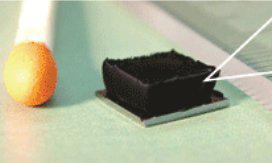Carbon nanotubes
Carbon nanotubes (CNTs) are allotropes of carbon with a cylindrical nanostructure. Nanotubes have been constructed with length-to-diameter ratio of up to 28,000,000:1, which is significantly larger than any other material. These cylindrical carbon molecules have novel properties that make them potentially useful in many applications in nanotechnology, electronics, optics and other fields of materials science, as well as potential uses in architectural fields. They exhibit extraordinary strength and unique electrical properties, and are efficient thermal conductors. Their final usage, however, may be limited by their potential toxicity and controlling their property changes in response to chemical treatment. Their name is derived from their size, since the diameter of a nanotube is on the order of a few nanometers (approximately 1/50,000th of the width of a human hair), while they can be up to several millimeters in length (as of 2008).
Carbon nanotubes are members of the fullerene structural family, which also includes the spherical buckyballs. They can be thought of as elongated fullerenes, just like this animation demonstrates on the example of a (5,5) nanotube. Carbon nanotubes — at least the uncapped ones — are often considered as rolled up graphene sheets, these animations are illustrating that fact on the examples of (10,10) and (10,5) nanotubes. There are numerous possible way to roll up a graphene sheet resulting in tubes of different chirality. The lateral surface of the nanotubes are built up of solely hexagons, while the ending caps might be a hemisphere of a fullerene structure, consisting of hexagons and pentagons too. Nanotubes are categorized as single-walled nanotubes (SWNTs) and multi-walled nanotubes (MWNTs).
Image below is borrowed from Kenji Hata et al., Science 306 (2004) pp.1362

- Log in to post comments

Recent comments